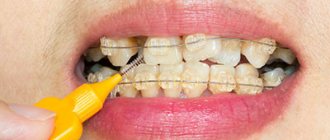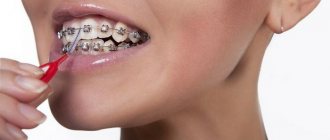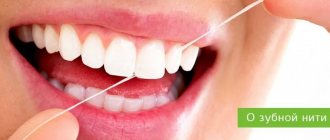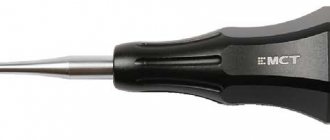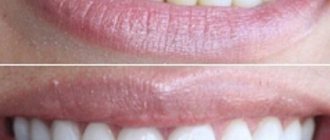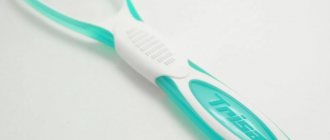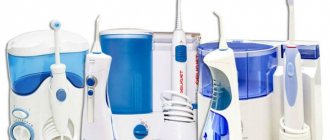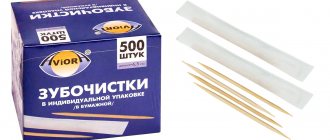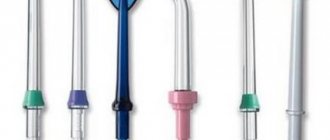The beauty of our smile and the condition of our teeth are a litmus indicator of the health of the whole organism. Therefore, the choice of oral hygiene products must be approached very responsibly.
But the trouble is that most of us use only toothpaste and a brush, ignoring other hygiene products. As a result, teeth are not cleaned well enough and deteriorate over time.
Interdental brushes will help to avoid this outcome, allowing you to better perform your daily hygiene procedure.
Choosing the right hygiene products: review of brush models and rules for their use
Most people associate daily dental hygiene with a tube of toothpaste and a toothbrush. If the brush is chosen correctly and the teeth are straight, these items are usually enough. However, such cases are actually rare; uneven interdental spaces, dentures or braces and other deviations from the standard require more careful oral hygiene. One of the devices that provide such care are brushes for cleaning teeth. As experts note, this is truly one of the most important devices.
Instructions for use
The device is very simple to use. The following rules must be followed:
- Brush your teeth and rinse your mouth.
- Rinse the product well.
- It is used without the use of toothpaste and tooth powder.
- Bring the device to the area to be cleaned.
- Holding the brush perpendicular to the surface being treated, carefully (without pressing) insert it into the interdental gap. Dentists recommend performing circular or reciprocating movements (you cannot move it up and down like a floss).
- It should easily and completely pass through the gap and emerge from the inside. If it is difficult to pass, it must be replaced with another one of smaller diameter.
- Remove the brush and rinse under running water.
- Bring it to the next gap and repeat the insertion as well (then clean all interdental spaces one by one).
- During the procedure, you should periodically rinse your mouth.
- After cleaning is completed, rinse the device with running water, dry it and close it with the cap supplied.
Periodically, the product must be replaced with a new one . An indicator for its replacement is the loss of stiffness and shape of the villi (depending on the model, this should be done 2-3 times a month).
The first few days of use are conventionally called the adaptation period, during which slight bleeding of the gums may be observed. Mouth rinses can cope with it.
If the bleeding is severe, inflammation or toothache occurs, you should stop brushing. The main reason for the development of this condition is an incorrectly selected brush. It is necessary to consult a doctor to select the optimal model.
Dental brush - what kind of device is it?
A dental hygienic brush for teeth is a thin rod-shaped base along which nylon bristles, or villi, are located. The bristles can be densely or sparsely spaced, have different lengths and thicknesses, and be hard or soft.
The brush nozzle itself is equipped with a handle holder, which can also have different sizes. Manufacturers make handles from different materials, but they are all easy to use, non-slip, and hypoallergenic. Look at the photo below - you will immediately understand what product we are talking about.
What is this
A dental brush is a special device that allows you to clean out food debris from between your teeth. In appearance, it resembles an ordinary household brush, reduced significantly.
The product consists of 2 parts:
- handle holder;
- working part (the brush itself).
There are many variants available. Between themselves, they depend on the size, hardness, density and length of the bristles, the material from which the rod for attaching the bristles is made, and the diameter of the working surface.
The brushes are suitable for daily use, easy to use, efficiently clean hard-to-reach areas, do not injure the mucous membranes, and are suitable for caring for healthy and affected areas. This is an ideal device for keeping your mouth clean when wearing implants, braces, and crowns.
A short video review of dental brushes can be seen in this video:
In what cases should this product be used?
It is recommended to use a dental brush in the following situations:
- requires more thorough oral hygiene than a toothbrush and even dental floss can provide,
- under normal conditions, the back surface of the dentition is poorly cleaned,
- pieces of food get stuck between the teeth, which cannot be removed using conventional methods (rinsing or brushing),
- a bracket system is installed on the dentition, the elements of which require better care,
- Plaque often accumulates on the enamel, and ordinary cleaning cannot cope with it.
If you find yourself with such problems, anyone can buy a brush for brushing their teeth and improve the quality of their oral hygiene.
“In addition to preventive and general recommendations for use, the products also have medical indications. For example, they must be used if braces are installed, if there are pathological changes in periodontal tissues. They are also indicated in the presence of crowding of dentition units or, on the contrary, in case of significant interdental spaces. In addition, the dentist may advise you to use a brush if you smoke, drink a lot of coffee or black tea, or often consume products with dyes - the device helps not only remove plaque from the enamel, but also prevent its staining,” says the expert, dental therapist Uspangalieva Nina Borisovna.
Reviews
Below are some customer reviews. If you have something to say, leave your feedback in the comments below the article, it will be useful to our readers.
Oksana, 32 years old.
I used to always use only a brush, but bad breath began to appear.
I thought there was something wrong with my stomach, but it turned out that I was just not brushing my teeth well)), or rather, in the wrong way.
After I started using the brush, the smell disappeared.
Denis, 36 years old.
I have braces and what a hassle it is to clean them every time after eating, especially with a brush.
Long, ineffective, inconvenient. The brush solved my problems in one go.
Although my wife doesn’t have braces, she also uses this device. Teeth look perfect.
How does the device work?
The principle of operation is based on the ability of the villi to penetrate into the most inaccessible places in the dentition, ensuring the cleaning of each individual tooth from all sides. Thin, but hard and dense bristles can remove even pigmented plaque (but not stone, of course).
The wire on which the villi are located is highly flexible, which makes it possible to clean remote areas of the oral cavity. A mild mechanical effect on the enamel acts as an abrasive (especially when smoking or drinking coffee), creating a whitening effect.
How to properly clean braces with a brush
You should take the purchase of the product seriously. It is chosen taking into account personal characteristics and parameters of the oral cavity. If the bristles are not long enough, they will not completely remove plaque and food particles. If, on the contrary, it is excessively high, then it can damage the gums and provoke the correction clasps to come off. When purchasing, pay attention to the thickness of the fibers. They must freely penetrate to all desired areas.
What types are there
There are three types of hygienic devices:
- cylindrical: have the same length of bristles throughout the base; They cope well with food stuck between teeth and help prevent periodontitis due to the high-quality removal of plaque from narrow spaces. Quite inexpensive and ubiquitous
- in the form of a cone: as you move towards the tip of the brush, the bristles become shorter, which makes it possible to penetrate deeper into interdental crevices of different sizes. They cost more than the previous option,
- curved: great for people who have braces installed, as they allow you to clean areas that are inaccessible to a regular brush (for example, under the clasps of braces, in the spaces between crowns, and so on). The cost is higher than other models.
Varieties
You can find many types of products on sale. They differ in shape and purpose. The classification of interdental brushes is shown in the table.
| Form | Description |
| Curved | The semicircle shaped handle is combined with a rod. These brushes are great for braces. Thanks to their semicircular shape, they easily remove plaque that accumulates in hard-to-reach places. Curved brushes are the most expensive |
| Cylindrical | The peculiarity is the same length of the fibers. This brush is used as an additional care for gums, in addition to a brush, and also to remove contaminants from the oral cavity. The device is suitable for installing an implant, since with the help of fibers of the same length you can remove dirt in hard-to-reach places. This is the prevention of periodontal disease. These brushes are considered convenient, and they are cheaper than others. |
| Cone-shaped | The bristles are arranged in a cone shape. The longest villi are at the base, and the shortest ones are at the end. This form is recommended for people who have the correct structure and an even row of teeth. The price of these products is average. |
What to look for when choosing
Manufacturers produce brushes for brushing teeth in different versions, so the question arises - how to choose the right one and what to pay attention to. When purchasing, it is extremely important to consider the following product characteristics:
- length of the device: a shorter one, marked S, is suitable for children, and a brush marked XL is preferable for adults; In addition, there are intermediate options,
- lint length: this parameter determines how good the cleaning will be; if there are large gaps between the teeth, you should choose a product with long bristles (at least three millimeters), with densely spaced units of the dentition you need bristles about 1-3 mm long,
- stiffness of the bristles: selected depending on the sensitivity of the gums and enamel layer - if it is high, bleeding gums are observed, the choice should be made in favor of soft bristles; in other cases, it is enough to purchase a product with medium-hard bristles,
- material: the main rod to which the bristles are attached can be metal or plastic; If the dentition is in perfect order, dentists recommend purchasing products with a metal rod; if you have high sensitivity of the enamel layer and dental problems, it is better to opt for plastic models.
It is important to know! In general, when choosing a product, you should focus on the individual characteristics of the anatomy of the jaws, the presence or absence of bridges, implants, braces and other nuances. Before purchasing, it is advisable to talk to your dentist to get professional recommendations. Remember that brushes are strictly prohibited when any prosthetic structures (crowns, bridges, etc.) and dental implants are installed in the mouth!
Selection rules
When purchasing a brush, you should pay attention to the following parameters:
- The length of the device itself .
There are 5 sizes available, and the optimal length is selected based on age. Thus, for children, a product with the shortest working part (designated S) is recommended. The maximum size is designated XL. Advice: it is very difficult to determine on your own exactly how long a brush is required. It is best to do this together with a doctor: after measuring the interdental distance, he will determine the desired size. - Villi length . Here you should focus on the size of the interdental space. Thus, for crowded units, it is recommended to use models with short villi (1 mm), and for trema and diastemas - with a length of 3 mm or more. It is also necessary to take into account the presence of orthodontic structures, implants and dentures. Products with short bristles are best for cleaning.
- Villi hardness . The devices are available with 2 types of bristles: soft and medium hard. Soft ones are approved for use for children, for periodontal hypersensitivity and for cleaning implants.
- The material from which the rod for attaching the bristles is made. Plastic or metal is used to make it. For weak and inflamed periodontal tissue, dentists recommend a brush with a plastic rod, since it is elastic and does not injure the mucous membrane and soft tissues.
- Handle length . This parameter is associated with the individual preferences of patients, i.e. whoever is more comfortable. Many manufacturers add stops, protrusions and rings to the handle, making it more comfortable.
Tip: a device with a smooth handle is difficult to hold in your hand when cleaning, so it is better to give preference to models with protrusions or stops on the handle.
We must not forget about quality. Your choice should be made on products from well-known global manufacturers who have proven themselves to be positive over the years.
How to use the product – with and without braces
How to use a dental brush correctly? The algorithm of actions is as follows:
- select and install the desired attachment on the holder,
- place the brush near the dentition at an angle of 90˚ relative to the front surface of the teeth,
- carefully insert the product into the space between the teeth so that its tip appears on the opposite surface,
- clean the interdental space by rotating the brush or moving it back and forth,
- do the same with the next gap,
- After cleaning, rinse your mouth with water or mouthwash.
You should brush your teeth with braces according to the same procedure, only you first need to clean the parts of the braces system, and then proceed to hygiene of the interdental space.
Products of the company Oral-B (Oral Bee)
Brushes belong to the category of hygiene products and allow you to maintain a healthy oral cavity.
All produced models are completed in sets and packed in special containers. If you need to take them with you on the road, this is very convenient.
They are produced in different shapes - cylindrical and conical.
A standard set of 6 cylindrical brushes is made for the narrowest gaps between teeth. They bend easily and penetrate into the most remote corners where a regular brush cannot cope with the task. Size 2.7 mm.
What is the best electric toothbrush for children aged 10 years and older? Let's find out.
In this article, we have prepared for you reviews of Listerine mouth rinse.
Here: https://www.vash-dentist.ru/krasota-i-uxod/zubnyie-pastyi/opisanie-parodontaks.html - they will tell you whether the price of Parodontax toothpaste is justified.
The conical brush set also includes a set of 6 nozzles. The cone-shaped head with small bristles is good for people with “sparse” teeth when the spaces between them are too large. Size 3-6.5 mm.
An assorted set is also offered, which includes one interdental brush and a starter set of two interchangeable attachments - conical and cylindrical brushes.
Nylon bristles do not scratch enamel, effectively removing dirt.
Rules for using the product
How to properly brush your teeth with brushes to get the desired effect, but at the same time, not harm your gums and enamel? During the hygiene process, you need to pay attention to the following points:
- before using a new brush, you need to treat it with an antiseptic solution: you can also boil it for 2-3 minutes if it is made of hard plastic, or treat it with a UV lamp,
- the nozzle should be changed at least once every 7-10 days,
- you need to brush your teeth with a brush without paste or powder,
- bleeding gums in the first 1-3 days after starting to use the product is a normal phenomenon that goes away on its own,
- Do not move up and down when cleaning,
- the device is not used to clean the incisors of both jaws,
- if the product does not fit well into the space between the teeth, you need to change the nozzle: choose a shorter bristles size,
- procedure duration 2 minutes,
- when inserting the rod between the teeth and during the cleaning process, you should not put additional pressure on the brush for a “better” effect: this risks damaging the enamel layer,
- You need to use the device twice a day,
- After the procedure is completed, the product is washed with water, treated with an antiseptic, and dried.
In addition, the quality of hygiene is also affected by the cost of the device - cheap models, as a rule, are made of low-grade materials that quickly become deformed and become unusable.
What not to do
There are restrictions when using brushes. During use it is prohibited:
- Use one product for more than a month. Ideally, the brush should be replaced once a week. The maximum time that the product can be used is 14 days. Even if upon inspection it is clean and suitable for use, it needs to be replaced.
- Apply toothpaste or tooth powder. A brush is used to clean teeth without using any products.
- Treat the incisors (4 upper teeth) and the spaces between the lower incisors.
It is not recommended to buy cheap products. If the price is too low, the product will wear out quickly.
Where can I purchase the product and what is its cost?
Devices for cleaning teeth are sold in pharmacy chains, online stores, dental clinics, and relevant departments of supermarkets. Usually these are sets that can contain both models with non-removable holders, as well as removable and several attachments. The set may also contain brushes of different sizes and shapes, and the price of the set depends both on the characteristics of the products included in it and on the manufacturer’s brand. The cost of a set of brushes can range from 200 to 1,500 rubles and more.
“I buy Lakalut in our hypermarket; five pieces in a package cost only 300 rubles. Enough for more than a month. Cleans great..."
Angela L. (from a message from the stomatologclub.ru forum)
Tools for caring for braces
Devices for caring for the oral cavity during orthodontic treatment may seem strange and uncomfortable at first glance, but they are not. If you are interested in where in Moscow you can buy an orthodontic toothbrush and brushes for cleaning braces, then just ask your dentist or search on the Internet. Today, most pharmacies and a large number of online stores offer a full range of hygiene products for patients undergoing orthodontic treatment. Moreover, the prices for these tools can vary, both from quite high for products of professional dental brands (for example, toothbrushes and brushes for Curaprox braces), and to absolutely affordable brushes from mass market brands (toothbrushes and brushes for Oral braces B (oral bi).
Advantages compared to other devices
The product has a number of advantages compared to floss, toothpicks and other oral hygiene items. Most often, users point to the following positive aspects:
- cheaper than an irrigator, with almost the same effect,
- Great for cleaning teeth with braces,
- if there are interdental spaces of different sizes, you can use different attachments of the product,
- They clean the bases of teeth well, especially the chewing group: these areas cannot be cleaned efficiently with conventional devices,
- promote visual whitening of enamel, preventing the accumulation of pigment in it,
- suitable for children.
In addition, brushes massage the gums, improving blood flow in them, thus preventing the development of many dental diseases.
Indications
A brush is an additional device for dental care, but dentists recommend that some categories of people use it. The main indications for use of the product are:
- wearing braces, dentures, implants and other orthodontic and orthopedic structures;
- large spaces between molars;
- crowding and irregular shape of crowns;
- presence of malocclusion and gum disease;
- discoloration of enamel due to smoking, consumption of products with dyes;
- accelerated formation of bacterial plaque due to impaired acid-base balance in the oral cavity.
In addition, it is advisable to use a brush daily to prevent various dental diseases, as an addition to a brush.
Read how much it costs to insert a tooth and what the cost of prosthetics is made up of. Click here if you are interested in how you can restore tooth enamel at home.
At this address https://dr-zubov.ru/lechenie/desny/v-chem-prichina-i-chto-delat-otoshla.html you will learn what to do if the gum moves away from the tooth.
Review of the most popular products
Which brushes are best for teeth? Below is a brief overview of the most popular brands, created based on reviews from online users.
LACALUT
LACALUT products are distinguished by the material they are made of - this is a special mass used for the production of surgical instruments. Great for cleaning teeth with braces. The protective cap can be used to extend the holder. Cost – 230-420 rubles.
CURAPROX
The manufacturer has tried to produce models for any purpose: simple teeth cleaning, with braces. The line includes products of different configurations and sizes. Can be used both for self-care of the oral cavity and for professional hygiene. Cost – 800-2000 rubles.
Plackers Interdental Mix
This set is perfect for a beginner – it contains products with different sized attachments. The rod is flexible and the holder is quite long. The kit includes a protective cap. Cost – 240-300 rubles.
PresiDENT
PresiDENT models are distinguished by their curved shape, comfortable holder, and compact size. They are mainly intended for people whose dentition is very dense and the spaces between the teeth are narrow. Cost – 240-480 rubles.
Oral-B
Products of this brand are also presented in a wide variety - brushes in the form of cones, cylindrical shapes, equipped with durable and convenient removable holders are available for sale. A plus is the presence of a hygienic storage container. Cost – 320-550 rubles.
Colgate
The company produces products for all occasions, having a variety of shapes and sizes of bristles and holder. High hygiene efficiency with Colgate brushes is achieved thanks to the triangular cross-section of the bristles. Cost – 350-650 rubles.
Purchasing and using a dental brush will significantly improve the quality of hygiene and improve the condition of the oral cavity. However, it is worth remembering that this product does not replace a regular toothbrush and toothpaste. Moreover, only comprehensive use of dental hygiene products will help maintain their health for many years.
Manufacturers
There are many companies producing brushes. Such as LACALUT, CURAPROX, Colgate Total, PRESIDENT, ROCS, Dentaid have taken leading positions in the global and Russian markets. Their products are of high quality and are made only from material that is safe and non-toxic to humans.
Products from
She has developed a wide range of products for cleaning the gum line, implants and orthodontic structures. Each person, taking into account the characteristics and condition of the oral cavity, can easily choose the appropriate option. Let's look at some of them.
CPS “Prime” is a universal model, suitable for both daily hygiene procedures and cleaning of orthodontic structures. In the brushes included in this series, the bristles are soft and arranged in a spiral; the rods are additionally coated with silicone, which increases their flexibility and reduces the likelihood of injury to the gums. There are 5 models in this version:
- CPS 06 is the model with the thinnest brush, has a blue handle marking, with a core diameter of 0.6 mm and bristles of 2.2 mm. The average cost is about 800 rubles.
- CPS 07 – has a slightly larger size, the handle marking is red, the shaft diameter is 0.7 mm, the bristles are 2.5 mm. Approximate price – 860 rubles.
- CPS 08 – pink handle, 3.2 mm bristles, 0.8 mm diameter core. The price is within 820 rubles.
- CPS 09 is a product with a yellow handle, bristles with a diameter of 4 mm and a shaft diameter of 0.9 mm. Costs on average 850 rubles.
- CPS 011 is the largest product with light green markings, a 1.1 mm shaft, and 5 mm fibers. Cost – from 700 rub.
CPS “Soft Implant” - designed for the care of orthodontic and orthopedic structures. The peculiarity of the model is that it can be used immediately after installation of an implant, bridge or any other surgical intervention. This is possible thanks to the presence of soft bristles made of monofilament.
Available in 5 variants:
- CPS 505 – blue product, with 5.5 mm bristles, shaft diameter – 2 mm. Cost of a set of 5 pcs. about 900 rub.
- CPS 507 – orange marking, product parameters: 2 mm rod, 7.5 mm fibers. Approximate cost – 910 rubles.
- CPS 508 is a black pen with 8.8 mm bristles and a 2 mm shaft. Average price for a set of 5 pieces. – 920 rub.
- CPS 512 – blue device with 12 mm bristles, 2 mm shaft. Cost about 940 rubles. per set.
- CPS 516 is a purple pen with a bristles diameter of 16 mm. The price ranges from 860 to 930 rubles.
Products
The German company produces sets of brushes in 4 sizes: S, M, L, XS (according to the international classification). Each size has its own color marking. So, S is red, M is blue, L is yellow and XS is orange.
All products are made from non-toxic high quality materials.
Lakalut brushes are suitable for use by people who have amalgam fillings and metal crowns.
Interdental brush No. 5, XS “ LACALUT” – designed for patients whose teeth are positioned differently and require special care during treatment (orthopedic or orthodontic). It is recommended for use with large interdental spaces; it cleans the gums well under an installed crown, implant, or prosthesis.
It comes with a cap that can extend the handle if necessary. The diameter of the villi is 2 mm. The average cost of a set is about 270 rubles.
You can find out the price of a mono-beam dental brush in our next article. In this review: https://dentist-pro.ru/krasota-i-uxod/sredstva/irrigatory/panasonic-ew-1211.html - you will find a description of the Panasonic DentaCare Handy EW 1211 oral irrigator.
And here you can read reviews about Mexidol Dent toothpaste.
Products
Swiss Colgate products are of high quality and combine all the latest technologies. Designed for people with interdental spaces of varying widths, to prevent the appearance of bedsores in soft tissues under crowns, implants, and dentures.
The products are packaged in sets of 3 pieces, and this set contains brushes of 3 sizes: 2 mm, 4 mm, 5 mm. They differ in markings: green, blue and red.
Colgate Total brushes 2 mm – green case handle, made of plastic and polyester, assembled length – 8 cm, diameter of bristles – 2 mm (located at an angle of 120°).
It has a high cleaning ability due to the triangular cross-section of the shape. Removes dirt from interdental crevices in hard-to-reach areas. Recommended for daily oral hygiene. Approximate price – 240 rubles.
Products
The products of this company from Italy occupy a leading position in sales. High global quality and a responsible approach to the development of brush models do not leave any buyer indifferent. Their wide range allows you to choose the right option for everyone. The ergonomics of the product ensures convenience and comfort of use.
Interdental brushes “ PresiDENT Classic XS ”, 0.28 mm. Designed for cleaning braces and dentures, ideal for people with tightly spaced teeth.
Its special feature is its wave-like shape, which allows the bristles to penetrate into hard-to-reach and narrow areas, removing accumulated plaque from them. The polypropylene handle does not slip when water gets on it during the procedure, and its geometric shape, repeating the anatomical structure of the palm, makes cleaning as convenient as possible.
The fiber material is Tynex nylon. All other parts are coated with safe polyurethane. The brushes are equipped with protective caps, which can be attached to the handle during use, thereby extending it. Cost about 270 rubles.
Products
Russian offers consumers a wide range of dental brushes of various shapes. All of them are made from materials that are safe for health and are easy to use.
Interdental brushes “ROCS minis” - set of 10 pieces, designed for cleaning braces, brackets and dentures, for daily use with narrow interdental spaces (with high crowding of units).
The bristles (diameter 2 mm) are made of nylon with the addition of microcrystals, which provide better cleaning. They do not scratch the enamel and do not injure the mucous membrane.
With daily use, it is possible to remove stains from tea, tobacco, coffee and pigmentation in the interdental areas within a few days.
The handle is made of polypropylene; if necessary, it can be extended with a cap. Price range – from 210 to 260 rubles.
Products
The Spanish manufacturer has developed several models of interdental brushes to suit the needs of each individual consumer.
Mini (1.1 mm) – recommended for normal arrangement of units in the dentition, conical (1.3 mm) – for patients with orthodontic products, diastemas and dentures, micro (0.9 mm) – suggested for use in case of crowded teeth, mix (1.0 mm) – for cleaning the space under removable dentures, implants and braces, nano (0.6 mm).
Interdental brush Interprox Plus Nano 0.6 mm - used for increased sensitivity of teeth and gums, wide interdental spaces, effectively cleans areas under fixed orthodontic products, implants, dentures. Model features:
- the head of the model is located at an angle, which ensures better penetration of the bristles into the tooth crevices;
- can bend in all planes due to the presence of 2 bending points of the rod;
- the bristles are made of Tynex fiber;
- the base of the product (rod) is made of steel and coated with polyurethane;
- Sold in sets of 6 pieces.
The average cost is about 260 rubles.
Why brushes cannot be used with implants and dentures
Some, even well-known manufacturers of dental brushes, indicate in the instructions that their products can be used with dentures, crowns, and implants. But this is just an advertising ploy to expand the customer base. In fact, implantologists are categorically against it, because Gums after prosthetics partially lose sensitivity. Therefore, it is enough to simply damage them with villi (even seemingly soft ones) and cause an infection - and then treat complications. Therefore, it is also prohibited to use toothpicks. And for patients with dentures and implants, it is better to give preference to an irrigator for washing the interdental spaces and subprosthetic space, or choose dental floss labeled “super floss” - the rest will not be suitable, since they are quite hard.
How is a brush better than an irrigator?
You can monitor the cleanliness of the oral cavity using a device such as an irrigator. It gently acts on teeth and gums, carefully removing food debris and pathogenic microorganisms. But irrigators have one significant disadvantage - high cost. Not all patients can afford such a device. But dental brushes are cheap and available to everyone. Moreover, they clean teeth and gums no worse than expensive irrigators.
To clean the spaces between teeth from food debris, many use dental floss or toothpicks, but they can damage the enamel or not completely remove plaque. Such devices are absolutely not suitable for those who have braces, implants or metal-ceramic crowns. If you have the listed structures in your mouth, it is better to use dental brushes.
Electric brush
Today, a device for cleaning the orthodontic system, such as an electric toothbrush for braces, is in great demand. When using it, it is possible to very quickly and easily clean tooth enamel and systems from plaque and excess food. The product is so popular due to its many advantages. This may include the following:
- You can perform high-quality cleaning of tooth enamel in a short period of time.
- The brush can be used by children and adults.
- It is possible to obtain maximum cleansing of tooth enamel and the area around the braces from plaque.
Choosing a quality brush for cleaning teeth with an orthodontic system is not so difficult. Almost all available models have the same effect; the main thing in this matter is to learn how to use them correctly. You can get the maximum effect if you listen to the recommendations discussed. If you refuse to use brushes, you risk developing any gum disease, which will only complicate your situation.
Sources used:
- Orto Solo - Dental Complex CJSC, St. Petersburg - October 2007
- Lutskaya, I.K. Preventive dentistry / I.K. Lutskaya. - M.: Medical literature, 2022.
- Pakhomov, G.N. Primary prevention in dentistry / G.N. Pakhomov. — M.: Medicine

